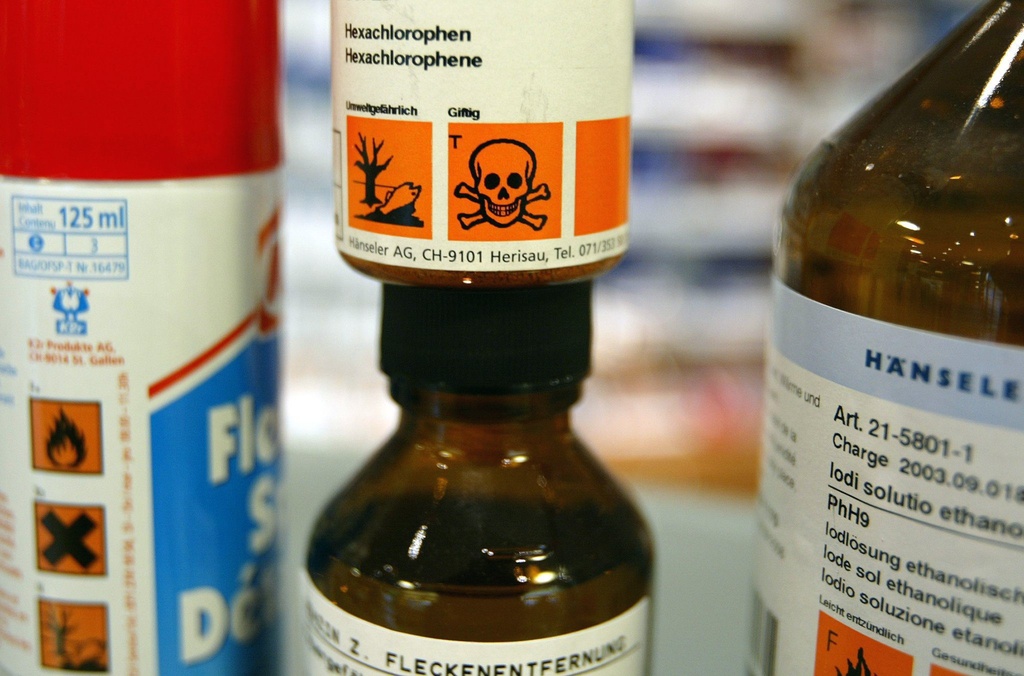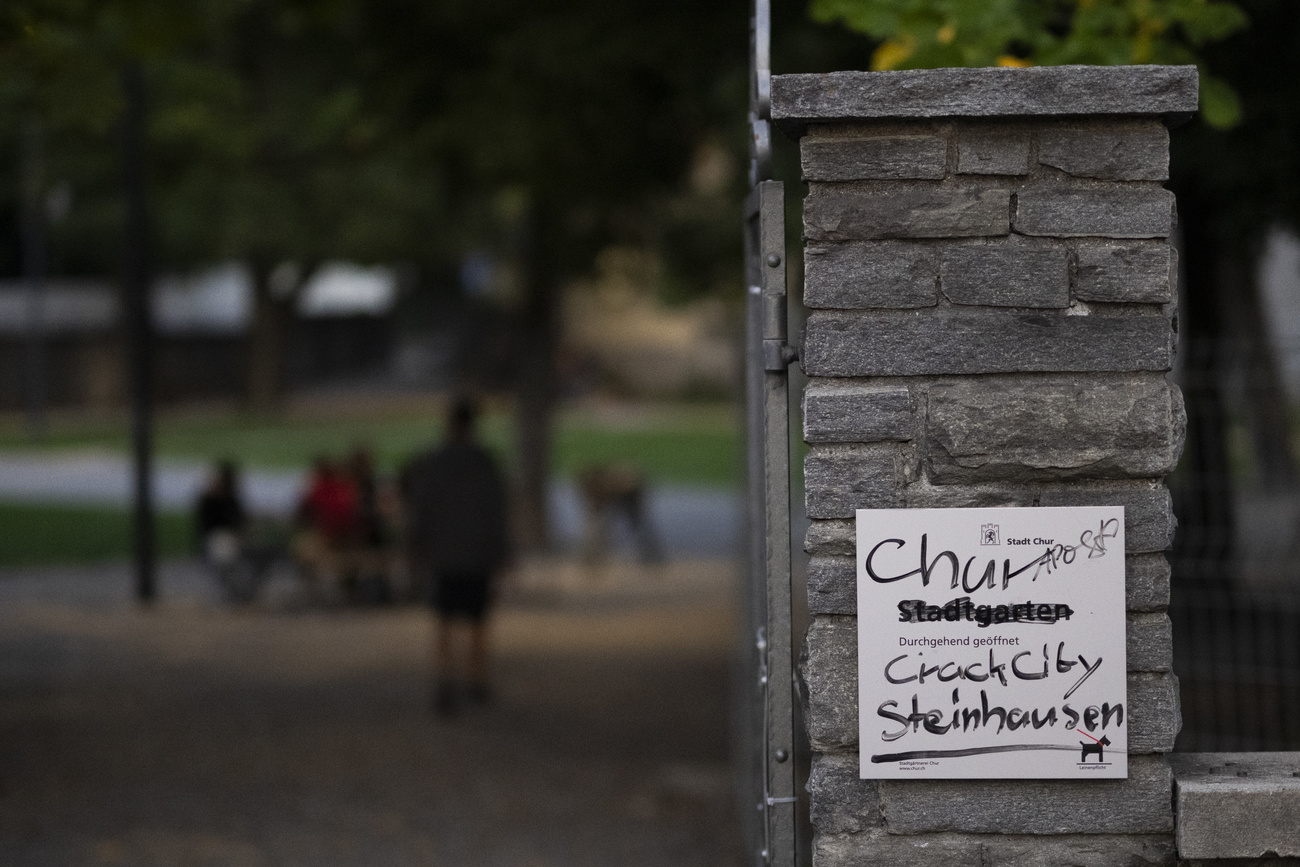Experts sound alarm over toxic accidents at home

More than 50,000 household chemical accidents happen each year in Switzerland despite products having warning labels, a study has found.
Overall the number of cases of accidental poisoning in the home has been on the rise during the last seven years. Experts are puzzled by the development.
Washing powders, drain cleaners and stain removers are common features of most households. Poison classes used to give information about the dangers contained in these products. These were replaced in 2005 by hazard symbols, in the form of text and orange pictograms, such as a skull to show that an item is toxic.
The move, outlined in a chemicals law, brought Switzerland into line with the European Union.
The Federal Health Office undertook a study, published last month, to see how households had reacted to the new system. They uncovered some alarming results.
“We saw that half of the people surveyed still think that the poison classes are the current system for communicating the dangers of those products,” Heribert Bürgy, head of the health office’s market inspection and information section, told swissinfo.ch.
Low awareness
People rarely take notice of the orange symbols, relying on other factors such as the colour of the bottle, thinking that green is safe.
“We think that people in Switzerland believe that if a product is in a supermarket it’s not dangerous,” Bürgy said.
The most toxic items are not available in self-service but have to be asked for at a specialist. “But even products which are not very dangerous may be so to children, the ill or the elderly,” he added.
Bürgy said that the health office was concerned about the study’s results and also by figures from the Swiss Toxicological Information Centre, which in January reported an increase in accidental-poisoning enquiries.
The Zurich-based centre, which gives advice on what to do in toxic emergencies, had more than 34,000 calls in 2009, two per cent up on the previous year.
Household items, which include cleaning products, lime-scale removers and fuels, accounted for 25 per cent of cases – a percentage which has remained stable over the past few years, said centre director Hugo Kupferschmidt. They were the second highest cause after medicinal drugs.
More poisonings
But during 2002-2009, there was a rise of 32 per cent in accidental poisonings of all kinds, with a particular increase in cases affecting small children.
“We don’t know exactly the reason behind this because the number of accidental exposures started to rise before the legislation was changed,” Kupferschmidt told swissinfo.ch.
“It must be something else. We also cannot exclude that the real number of incidents has remained the same, but more people are calling us. We are counting the number of calls we get. Nobody knows how many accidents truly occur in homes.”
There is no obligation to report such accidents in Switzerland.
Bürgy is also unsure whether the system change and the rise are linked and said that the issue would be further investigated. It was, however, clear that the health office had to raise awareness of the warning labels, he said.
Informing the public
This would involve targeting those stocking the products, as well as offering better training for people dispensing more dangerous substances. “We will also create some school lessons so teachers can instruct their pupils more directly,” he said. A public campaign is going to be launched next year.
Kupferschmidt agrees a campaign would be a good idea. “If people are not aware enough of the symbols, they have to be made aware. But I think the symbols themselves cannot be changed. I would not expect if they became bigger people would become more aware of them.”
People’s bad habits also need to be addressed, he added, for example pouring dangerous chemicals into drinking bottles and not properly labelling them.
Consumer groups said they were surprised about the low public awareness of the orange labels. “Usually people are very well informed about everything, they could go and look on the internet, but in this case, maybe people are not so interested in the issue,” Muriel Uebelhart, head of the Swiss Consumers’ Forum, told swissinfo.ch.
Her organisation has been informing people since 2005 and has produced a leaflet which can be printed out and put up in a cupboard housing cleaning products or in the laundry.
“I think the study shows that you always have keep informing people – that’s the important point from this,” said Uebelhart.
Isobel Leybold-Johnson, swissinfo.ch
The Federal Health Office mandated a company to carry out the study. For this, scientific literature on the topic was assessed, specialist experts were questioned, everyday behaviour was observed in 20 households and 1,227 people from the Swiss population were questioned online. The data collection period was October 2008 and April 2009.
Almost two per cent of the online participants had experienced an accident with chemical household products in the last year. This extrapolates to around 56,000 households in Switzerland. A quarter of them required medical treatment with costs.
The study was limited to hazardous chemical products found in a conventional household cleaning cupboard.
When the new Chemicals Act came into force in August 2005, Switzerland harmonised its chemical products labelling regulations with those of the European Union. Before that it had poison classes. There was a transition period until 2007.
Labelling is undertaken with the hazard symbols (orange and black) and an explanatory word (hazard name) such as “irritant”, “toxic” or “dangerous for the environment”.
In addition the product label bears risk phrases (R phrases) like “causes burns”, safety phrases (S Phrases) like “avoid skin contact” and the name of the hazardous constituent.
(Source: Awareness of hazardous chemical products study)

In compliance with the JTI standards
More: SWI swissinfo.ch certified by the Journalism Trust Initiative











You can find an overview of ongoing debates with our journalists here . Please join us!
If you want to start a conversation about a topic raised in this article or want to report factual errors, email us at english@swissinfo.ch.